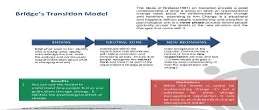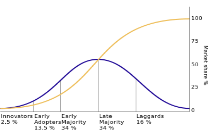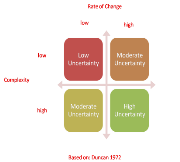Impacts and Causes of Quality Implementation Failures
Â
INTRODUCTION:

Due to, the increased competitiveness and arduous customers who desire to have high quality products at lowest prices; quality is acknowledged as a source of competitive advantage and have a higher strategic importance, is essential for success. (Spector and Beer 1994; Eskildson 1994) studies have shown that in organizations there are a lot of quality implementation failures, causes for theses failures are due to environmental uncertainty, Firm orientation, and Total quality management (TQM) was not properly addressed. (Puffer and McCarthy 1996)
UNCERTAINTY: It means lack of assurance, about something and facts in decision making (Duncan 1972; Lawrence and Lorsch 1967).
ENVIRONMENTAL UNCERTAINTY: It is a state, when conditions are constantly changing within a business environment (jauch and kraft 1986). Environmental uncertainty takes place by complete customer knowledge and for more worth in products and services. It has promoted the business scene, accordingly, feat of any organization now rely more on its ability for delivering quality products and services to customers. So, Business organizations are now confronted with a triangle of problems that they must sort out for building sustainability and success. This is by practicing uncertainty, strategy, and quality.
- UNCERTAINTY DIMENSIONS:
Environmental uncertainty rises or falls as environments differ along five simple dimensions:
Homogeneity-heterogeneity: It is the number and range of areas having impact on the organization.
Concentration- dispersion: it is interconnection between components of the environment
Stability-turbulence: The rate and scale of change in the environment
Resource Scarcity- Resource Munificence: richness and accessibility of resources
Hostility-Supportiveness: it is the degree of competition and level of getting of the organization
The challenge of current companies is to endure and grow while growing in a complex and harsh international market. Change has to be eternal, for example, as the attainment of new abilities. Change can thus only be observed as the important attitude of an organization. By evaluating this environment offers vision of the unique changes, the effects of these changes have on a firm’s strategies, and the making of special methods required understanding them.
- CHANGE MANAGEMENT
Organizational change management (OCM): It is an organization structural process, used for safeguarding that changes are easily and effectively implemented, and that the lifelong benefits of change can be accomplished.
CHANGE MANAGEMENT MODELS:
- KOTTER’S EIGHTS STEPS TO CHANGE

This model copes for knowing and handling change. Every stage admits an important principle linking to people’s reaction and approach to change, where people understand, sense and then make change. The model is intended on research which demonstrates that there are eight critical steps an organization or team demands to use in order to make sure that change occurs and sticks properly. (Kotter, 1996)
- BRIDGE TRANSITION MODEL:
With the support of Bridge transition model, we can have awareness about the feelings of our workers and operate conditions according to the way that hold the changes committedly.
                                  ÂÂ
                     
It is a three phase procedure, where people slowly adopted the facts of new circumstances and the change that derived with it.
- ROGER’S TECHNOLOGY ADOPTION CURVE:ÂÂ
                                                 
It defines the acceptance or adoption of a new innovation or product, along with the psychological and demographic features of acceptor groups. It is exemplified as “bell curve.” The model shows that first group of people that use a new product is “innovators,” and subsequent is “early adopters.” Next group is early and late majority and the last group that finally accept a product are called “laggards.” The curve makes the base of 5 step procedure of technology adoption; Knowledge, Persuasion, Decision, Implementation.
- KUBLER- ROSS FIVE STAGE MODEL
                                       
This Model was developed by Elisabeth Kubler-Ross in 1960s. It is use to describe the grieving procedures. She suggests a sequence of feelings practiced by fatally ill patients before death, in which the five stages are anger, bargaining, depression denial, and acceptance. The Change Curve was a firm feature in change management circles By the 1980s. The curve, and its related emotions, can be accustomed to predict that how performance is probably affected by the declaration and following implementation of a vital change.
- PROSCI’ ADKAR model
                                                 
This Model offers a modest and action-focused five-step procedure. It is used by managers, directors and even workers to recognize and eliminate fences for making positive change. Individuals make changes effectively when they contain the essential Awareness, Knowledge, Desire, Ability and Reinforcement.
- PARTICIPATORY METHODS:
                                                                    
It contains a sequence of actions with a common line. It allows common people to play a dynamic and significant role in making choices which affect their lives (Participatory Methodology Facilitation Guide, 2000). This method is used by publics, researchers, and donors. Its outcome is involvements of local realities, and it direct towards a well-supported and permanent social change.
EXTENT OF UNCERTAINTY: It is the degree of rise in environmental vitality and intricacy (Johnson and Scholes 1999). Therefore, in complex environmental situations there are, larger level of uncertainty in the environment
                                     . 
Low uncertainty: An environmental change affecting the uncertainty is low. For example, variations in customer tastes are low, perhaps because of there are less factors that influence on demand.
Moderate uncertainty: It links between low complexity and high dynamism.
High uncertainty: The environment is extremely dynamic a d intricate and the links among the modules of the environment and the organization are uncertain. This makes selections more problematic. For instance, the broadcastings business is facing some uncertainties about technology, government rules, demand etc. All these uncertainties link in changeable techniques and use to predict the environment and improve reasonable choices.
- Strategy and Environmental Uncertainty
They are closely related to environmental uncertainty. The degree of uncertainty perhaps is objective and assessable or subjective and apparent. The significant matter is that in such environments how organizations behave. (Zahra, 1987) determines that businesses that follow diverse type of strategic aspects will be inclined to observe their environment in a different way. (Hambrick, 1983), (Miller, 1986), (Snow and Hrebiniak, 1980) usually determined that these strategy types acts inversely under different environmental situations.
- STRATEGIES TO DEAL WITH UNCERTAINTY IN ORGANIZATIONS:

           There are number of strategies that are used by organizations to encounter uncertainties of the business environment. (Miles and Snow, 1978) strategy is a strong description of the strategic behavior of organizations. It redirects a wide number of strategies and complete view to strategy conceptualization (Venkatraman, 1989).
- Four Basic Strategy types: The organizations can implement one of four approaches when retorting to uncertainty in their environment: (Miles and Snow, 1978)
- Prospector: (Miles and Snow, 1978) organizations adopted or follows this strategy is highly advanced and continually seeking out new markets and new prospects and they are oriented towards growth and risk taking. Firms can use3M strategies. And Johnson & Johnson Company relate decentralization with a prospector strategy.
- Defender: It focuses on accommodating its present markets, keeping steady growth, and serving its present customers. For example, BIC Company used defender strategies; it has implemented a less violent, less business style of management and has taken to protect its considerable market share in the industry.
- Analyzer: An organization that assumed this strategy has market share and seeks to be groundbreaking. For example, IBM uses analyzer strategies. Thousands of their clients have bought IBM computers over the last some decades. It is in IBM’s attention to keep these clients content and to lead new products and services that modernize their computer amenities. Another example contains Proctor & Gamble (P&G) has proven numerous name brand products, for instance Tide laundry and Crest toothpaste, it is significant for P&G to stand to invest in its effective products, so as to keep financial performance
- Reactor: (Miles and Snow, 1978) an organization that monitors a reactor strategy has no reliable strategic approach; it floats with environmental proceedings, reacting to but failing to anticipate or influence those events.
According to (Miles and Snow, 1978) organizations adopt a methodical and distinguishable outline of behavior toward environmental adaptation. An organization’s strategy tackles three types of complications,
- Entrepreneurial: This relates that how an organization faces itself to the market.
- Engineering: It refers to the technical system of the organization.
- Administrative: It refers that how an organization tries to organize and implement its strategies, specifically, control, structure, and procedure issues.
- TECHNIQUE’S FOR MANAGING CHANGE EFFECTIVELY

For Successfully Managing the change needs a shifting of the firm from its present condition to the state according to its future needs at negligible cost to the organization. (Wallington, 2000) Key steps are as follows:
- Firstly, familiarity with the present state is very necessary. This includes finding problems that company faces, assigning a degree of status to each person, and evaluating the kinds of changes required to resolve the problems.
- It involves imaging the Future state of the organization. This includes considering the perfect state for the company after the implementation of change, assigning this vision perceptibly to everyone involved in the change endeavor, and designing a waysof change to the new state. Stability is an important part of the transition for instance the company’s mission and workers should help constantly in the uncertainty in order to aid and reduce people’s unease.
- All change should include employees at certain level. Organizational change needs to be clarified and linked, especially changes that affect how employees do their jobs.
- It involves the Implementing of change in well-ordered manner. This contains managing the transition successfully. It is supportive to assemble a plan, assign resources, and employ an important person to take responsibility of the change procedure. For this, The Company’s leaders must do effort to create interest for the change by partaking their aims and vision and acting as role models. (Murray and Greenes, 2006)
- When a change process is done, it is always worthy to follow-up after implementation and measure how the change are employed and whether the implemented change deliver the intended results.
- Conclusion
The current day organizations main challenge is to endure and even grow while developing in a complex and cruel international market. Change must be eternal, just as the gaining of new capabilities. Management plays very important role in bringing and implementing change in an organization proper functioning. While dealing with uncertain environment in business organization, there is also of responsibility come to on their shoulders. Manager’s challenge contains originating the change central for the company, so that assemble the human energy toward building and action, so as to correspond the structures with the accessible human potential. Thus, Personnel will be the performers of an evaluative procedure instead of the sufferers of a revolution. Change can hence only be observed as the important approach of an organization. It should ensue as a natural and liberal behavior that is applied by personnel themselves. The Change Management also play vital role in organization’s uncertain circumstance it familiarizes and monitors organizations through complex and problematic changes. CMG is a global management referring secure staff by Manufacturing and Structural MBAs and Psychologists
REFRENCES:
Wallington, Patricia M. “Making Change.” CIO. 1 April 2000
PDF: Participatory Methodology Facilitation Guide. WaterAid. 2002.
Kotter J, (1996), Leading Change, Boston:Harvard Business School Press
Wallington, Patricia M. “Making Change.” CIO. 1 April 2000.
Wischenvsky, J. Daniel and Fariborz Damanpour. “Organizational Transformation and Performance: An examination of three perspectives.” Journal of Managerial Issues. Spring 2006.
Murray, Art and Kent Greenes. “The Enterprise of the Future.” KMWorld. March 2006.
Spector, B., and M. Beer. 1994. Beyond TQM program. Journal of Organizational Change Management 7, no. 2: 63-70.
Puffer, S. M., and McCarthy. 1996. A framework for leadership in TQM context. Journal of Quality Management 1, no. 1: 109-130.
Duncan, R. B. 1972. Characteristics of organizational environments and perceived environmental uncertainty. Administrative Sciences 17: 313-327.
Jauch, L., and K. Kraft. 1986. Strategic management of uncertainty. Academy of Management Review 11: 777-790.
Zahra, S. 1987. Corporate strategic types, environmental perceptions, managerial philosophies, and goals: An empirical study. Akron Business and Economic Review (Summer) 18, no. 2: 63-74.
Snow, C. C., and L. G. Hrebiniak. 1980. Strategy, distinctive competence, and organizational performance. Administrative Science Quarterly 25: 317-335.
Hambrick, D. C. 1983. Some tests of the effectiveness and functional attributes of miles and snow strategic types. Academy of Management Journal 26, no. 1: 5-26.